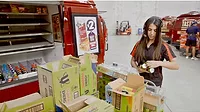Less-Than-full Pallet Methodology: Pick-to-belt or Pick-to-pallet?
![]()
Less-Than-full Pallet Methodology: Pick-to-belt or Pick-to-pallet?
There is an old maxim in
the consulting business that if you ask two consultants the same question,
you get four answers. Not being one to shatter a stereotype, the answer to
the title question is not a direct one. Rather, it requires some navigation
of the issues that would suggest one methodology over the other.
Beverage distributors who are dealing in
less-than-full pallet or layer quantities employ one of two general methods
to select individual cases or retail units: Selection onto a pallet being
transported with a pallet jack (a.k.a. “pick-to-pallet”); or a
method known as “pick-to-belt,” in which an order-selector
places individual cases or totes onto a conveyor for transport to a
sortation and palletization area.
When I first began my career in the warehousing
business, “mechanized systems” were the concepts of fancy. The
notion of modern conveyors and sortation devices humming endlessly,
whisking cases from the item’s home slot to be stacked on the truck
for outbound delivery, made both warehouse managers and chief financial
officers get misty-eyed over the “savings” these systems were
providing.
It wasn’t that long ago that warehousing
executives were criss-crossing the country to observe the latest conveyor
belts that would extend into a shipping trailer for case loading, or the
system that utilizes blinking lights on the rack to indicate the location
and quantity of cases to be selected for placement onto the takeaway
conveyor belt.
The standard configuration calls for approximately three to
four layers of selection mezzanine serviced by numerous aisles of reserve inventory.
Order selectors pick cases onto conveyor belts, applying selection labels while
doing so.
Typically, this is done in a “batch mode,” wherein the selector picks cases for multiple customers simultaneously.
Typically, this is done in a “batch mode,” wherein the selector picks cases for multiple customers simultaneously.
Cases are conveyed to a sortation system that
separates orders by outbound truck (or customer, depending upon the
condition) and the case is either floor stacked onto the truck or
palletized for outbound delivery. The limit of how many customers can be
selected simultaneously is usually determined by the number of
palletization stations.
While touting the virtues of such a system, a nameless
salesperson comes to mind who uttered the classic, “No pick-to-pallet
process will ever come close to our productivity; we’re getting 450
cases per hour.”
Impressive, no? In fact, the salesman was telling the
absolute truth. What he failed to mention was that the performance quota
was merely the rate for putting the cases on the conveyor belt at the
selection slot; he did not include the rate for taking them off at the
shipping dock for stacking onto a pallet or route truck floor.
Performance for removal of cases is roughly the same
as selection, so if we’re selecting at 450 cases per hour and
palletizing at the other end at 450 cases per hour, the gross performance
of the selection process is 225 cases per hour for a completed pallet. This
is still an impressive productivity number, but not the touted 450 cases
per hour.
As the above-described systems continue to propagate,
conventional, non-mechanized operators continue to push for tools and
processes that will help them in their effort to become more efficient.
They are working to match the productivity benefits offered by suppliers
who install mechanized solutions.
Among the advancements for conventional operators are
double- and triple-position pallet jacks, paperless RF voice selection,
engineered labor standards, productivity-based cash incentives, and
assignment-specific performance targets, to name a few.
The list goes on but the result of these and other advancements
is that a 225 crew average for selection cases per hour is now being achieved
on a regular basis with conventional pick-to-pallet systems. This
performance parity is based solely on selection; the replenishment process for
the mechanized system is an entirely different story. It essentially requires
a three-step process. One operator selects cases from a reserve slot, the next
operator transports those cases to the prescribed level within the system where
the selection slot resides, and the final operator transports the cases via
catwalk to deposit them in their respective slots.
Suffice to say that the expense of performing the receiving and replenishment tasks are nothing short of a nightmare.
Suffice to say that the expense of performing the receiving and replenishment tasks are nothing short of a nightmare.
Early in this commentary I mentioned that the previous
is targeted to distributors who are typically shipping less than a layer of
any given SKU. For those who are shipping by layer, the mechanized
suppliers have pushed the state-of-the-art and are now regularly automating
both the selection of a layer of like product and the palletization of
those layers for outbound shipment.
This has become a tremendous opportunity for
manufacturers and distributors to respond to a customer’s specialized
needs. With this system, display, promotional, or “rainbow”
pallets can be automatically assembled to the specification of the
customer.
As “Fortune 1 companies” (i.e., Wal-Mart)
push the envelope to reduce the cost of delivered goods, manufacturers and
distributors are responding with the requirement that entire layers of an
item be ordered. As a result, the benefits of automated order selection and
palletization can be completely realized by all.
For the one- and two-case orders, our clients are
resoundingly shifting away from mechanized selection and toward pallet
jack, floor-based case and bottle selection onto pallets. Among the reasons
are:
The ability to add labor in the form of pallet jacks and
order selectors during peak periods. With sufficiently wide selection
aisles, order selectors can pass one another and multiple employees
can work in the same area.
Streamlined, floor-level replenish- ment processes. Gone is
the requirement for slots to be replen- ished utilizing elevated order pickers
(PIR) or suspended mez- zanines with catwalks. With the floor-based, non-conveyorized
model, reserve pallets are stored directly above the selection slot with forklifts
that are able to refill slots on demand.
Eliminating “zone” style selection that is mandatory
with pick-to- belt processes. Everyone works until his assignment is complete.
With pallet-jack selection, there is no need to discontinue all selection
in the system while the slowest individual finishes.
Single-person, assignment- specific order accuracy account ability.
Single-person, assignment- specific order accuracy account ability.
The bottom line? For those who are in a position to
ship full layers to a customer, automation is not yet a viable proposition.
While strides are being made, a magic solution that makes single-case,
mechanized selection viable has not yet
emerged.
For the less-than-layer orders of a specific SKU, we
recommend a floor-based pick-to-pallet system utilizing pallet jacks and
order selectors. In fact, our most recent beverage client incorporated both
full-case and individual bottle selection into their pick-to-pallet
process.
John B. McGlasson is vice president of logistics for
Food Tech Structures LLC, a planning, engineering and construction firm
based in Hanover, Mass., and manager of Food Tech’s West Coast office
in Los Angeles. He has more than 20 years experience in the distribution
industry, specializing in conventional and automated facility planning, and
the development of distribution strategies to achieve maximum logistics
return on investment. John can be reached at 310/980-4204, or by email at
jmcglasson@foodtechstructures.com.
www.foodtechstructures.com
www.foodtechstructures.com
Looking for a reprint of this article?
From high-res PDFs to custom plaques, order your copy today!




